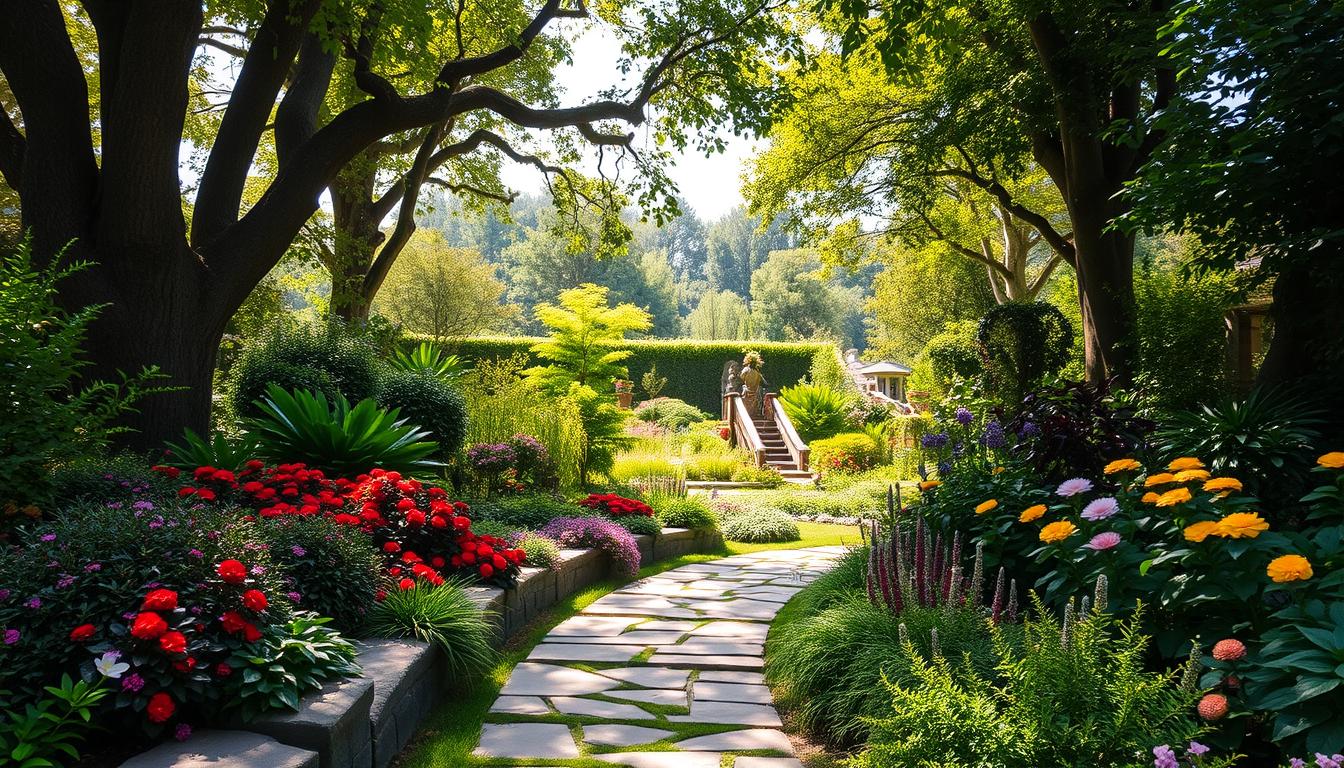Creating a beautiful and functional outdoor space is both an art and a science. With the right planning, even the smallest yard can become a productive oasis. Whether you’re working with a sprawling lawn or a compact area, strategic layout choices can make all the difference.
Take inspiration from real-world examples, like Steven Biggs’ neighbor, who transformed a simple front lawn into a thriving haven. This shows how adaptability and creativity can turn any space into something extraordinary. Different climates and personal preferences can also be accommodated with thoughtful design.
In this guide, we’ll explore key strategies to elevate your outdoor area. From vertical gardening to raised beds and companion planting, these methods ensure your plants thrive while maximizing available space. Let’s dive into how you can create a stunning and sustainable yard that suits your needs.
Key Takeaways
- Strategic planning transforms any yard into a functional and beautiful space.
- Real-world examples inspire creativity and adaptability in design.
- Vertical gardening and raised beds maximize limited areas.
- Companion planting enhances plant health and productivity.
- Thoughtful layouts accommodate different climates and preferences.
Introduction to Garden Planting Layouts
Edible landscapes are reshaping how we view traditional lawns. Instead of purely ornamental designs, many homeowners are embracing the idea of growing their own food. This shift is evident in urban areas, where small shaded spaces are being transformed into thriving vegetable gardens.
Steven Biggs, a gardening expert, has helped neighbors redesign their front yards into productive spaces. His approach emphasizes creativity and adaptability, treating every yard as a unique canvas. By combining different plants and techniques, even the smallest areas can yield impressive results.
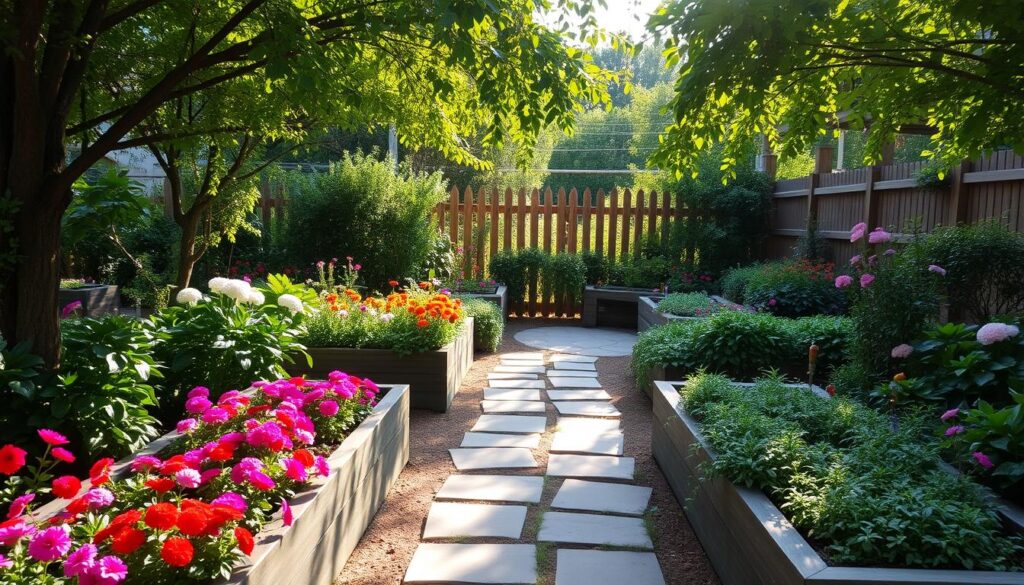
Traditional row farming is giving way to modern block planting methods. These techniques maximize space and improve plant health. For example, mixing herbs, vegetables, and flowers creates a balanced ecosystem that supports growth and deters pests.
Biggs’ philosophy revolves around the concept of “food garden life.” This approach encourages mixed plantings that not only look beautiful but also provide a steady supply of fresh produce. Whether you’re working with a large backyard or a compact urban plot, these strategies can help you make the most of your space.
If you’re new to gardening, check out this beginner’s guide to get started. With the right planning, your yard can become a vibrant and productive oasis.
Why a Well-Planned Garden Layout Matters
A thoughtfully designed outdoor area can transform your space into a thriving oasis. Rooted Garden, a leader in innovative designs, has proven this since 2015 with their raised bed systems. Their success highlights how strategic planning can elevate both productivity and beauty.
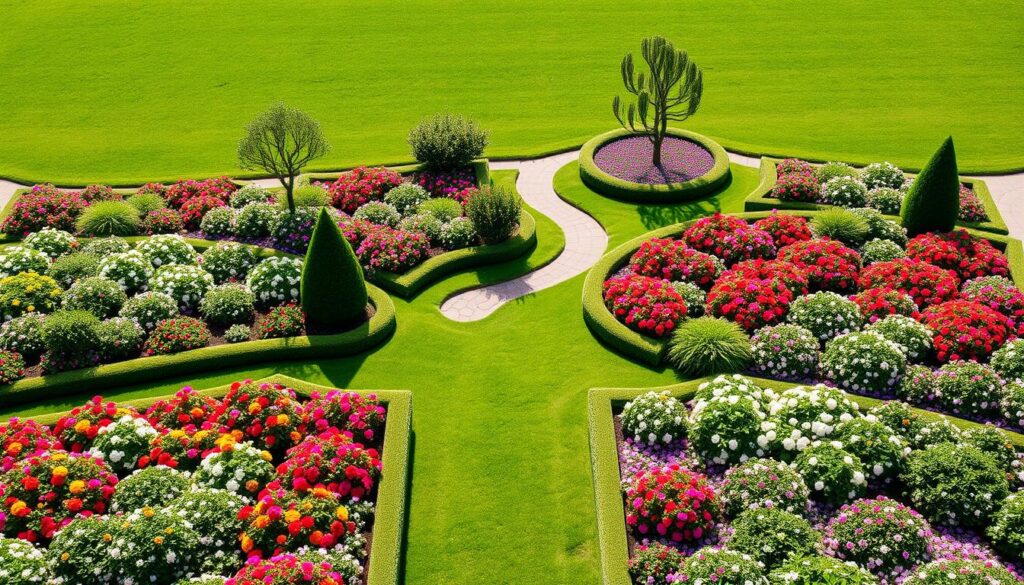
One of the biggest advantages of a well-organized setup is increased yields. By spacing plants strategically, you can boost productivity by 40-60%. This approach ensures each plant has enough room to grow, reducing competition for nutrients and sunlight.
Smart crop placement also helps prevent pest infestations. For example, placing marigolds near tomatoes can deter harmful insects naturally. This method reduces the need for chemical treatments, making your garden healthier and more sustainable.
“Proper planning extends the growing season by optimizing sun exposure,” says a Rooted Garden expert. This ensures your plants thrive even in cooler months.
Visual appeal is another key benefit. Combining colors and textures creates a stunning display that enhances your outdoor area. For inspiration, check out this boho backyard decor guide to add personality to your design.
Efficient pathway designs reduce maintenance and improve accessibility. This allows you to enjoy your garden without spending hours on upkeep. Here’s a quick comparison of traditional vs. modern designs:
| Aspect | Traditional Design | Modern Design |
|---|---|---|
| Yields | Moderate | High (40-60% increase) |
| Pest Control | Chemical-dependent | Natural methods |
| Growing Season | Limited | Extended |
By focusing on these elements, you can create a garden that’s not only productive but also a joy to spend time in. Whether you’re a beginner or an experienced gardener, thoughtful planning makes all the difference.
Choosing the Right Plants for Your Garden
Selecting the perfect plants for your outdoor space starts with understanding your environment. Climate and soil play a huge role in determining which plants will thrive. By focusing on these factors, you can create a vibrant and productive area that suits your needs.
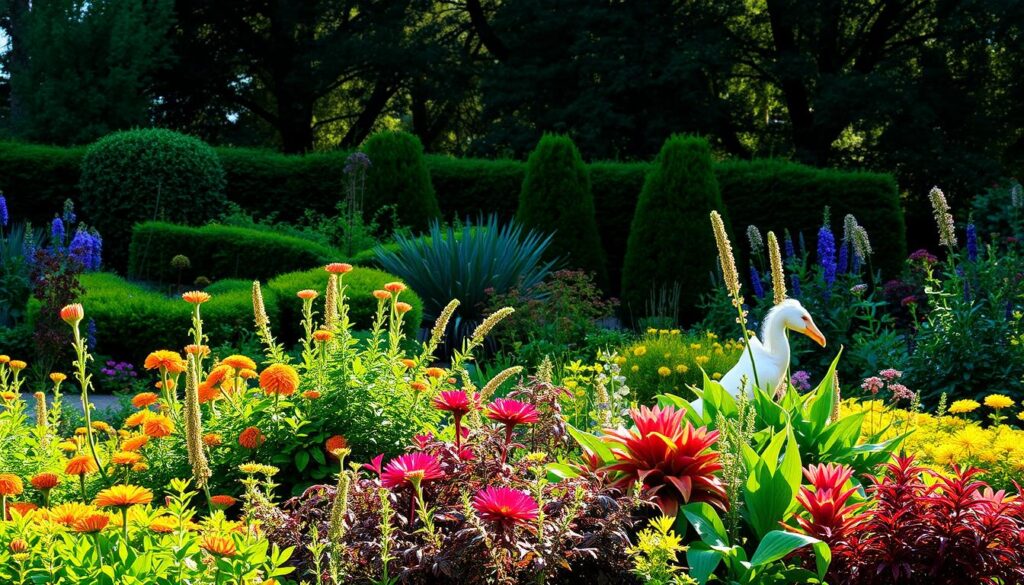
Consider Your Climate
Your local climate is a key factor in plant selection. Start by identifying your USDA hardiness zone. This helps you choose plants that can withstand your region’s temperature extremes. For example, drought-resistant varieties like lavender or succulents are ideal for arid areas.
Shade-tolerant crops, such as Malabar spinach, are perfect for spots with limited sunlight. Biggs’ climate adaptation strategies emphasize choosing plants that naturally thrive in your area. This reduces the need for extra care and ensures healthier growth.
Soil Preparation
Healthy soil is the foundation of a thriving outdoor space. Begin by testing your soil’s pH and nutrient levels using a soil testing kit. This helps you determine what amendments are needed for optimal growth.
Adding organic matter like compost can improve soil structure and fertility. Biggs recommends balancing pH levels to match the needs of your chosen plants. For example, most vegetables prefer slightly acidic soil with a pH of 6.0 to 7.0.
| Climate Type | Recommended Plants | Soil Requirements |
|---|---|---|
| Arid | Lavender, Succulents | Well-draining, sandy soil |
| Shaded | Malabar Spinach, Ferns | Rich, loamy soil |
| Temperate | Tomatoes, Peppers | Slightly acidic, fertile soil |
By matching your plants to your climate and preparing your soil properly, you can create a thriving and beautiful outdoor space. Whether you’re growing flowers, herbs, or vegetables, these steps ensure success.
Maximizing Space with Raised Beds
Raised beds are a game-changer for anyone looking to optimize their outdoor space. They offer numerous benefits, from better soil control to improved accessibility. Whether you’re growing vegetables or flowers, these structures can transform your garden into a productive and visually appealing area.

Benefits of Raised Beds
One of the biggest advantages of raised beds is their ability to maximize space. By elevating the soil, you can plant more densely without sacrificing growth. This is especially useful in smaller areas where every inch counts.
Raised beds also improve soil quality. You can customize the soil mixture to suit your plants’ needs. A common blend is 60% topsoil, 30% compost, and 10% perlite. This ensures proper drainage and nutrient availability.
Accessibility is another key benefit. Ideal dimensions for raised beds are 4×4 feet, making it easy to reach the center from any side. This is particularly helpful for those with mobility issues.
Building Your Own Raised Beds
When it comes to materials, you have several options. Cedar is a popular choice due to its durability and resistance to rot. Composite materials are also a good option for longevity, while stone offers a more permanent and aesthetic solution.
Proper drainage is essential, especially in wet climates. Adding a layer of gravel at the base can prevent waterlogging. Rooted Garden clients have shared success stories of thriving plants thanks to well-drained raised beds.
Here’s a quick comparison of materials:
| Material | Pros | Cons |
|---|---|---|
| Cedar | Durable, rot-resistant | Higher cost |
| Composite | Long-lasting, low maintenance | Less natural look |
| Stone | Permanent, aesthetic | Heavy, difficult to install |
By choosing the right materials and following these tips, you can create raised beds that enhance your garden and make the most of your available space.
Vertical Gardening: Growing Up, Not Out
Vertical gardening is a smart way to make the most of limited space. By growing upwards, you can maximize your growing area and create a lush, green environment. This method is perfect for small yards, balconies, or even indoor spaces.
Steven Biggs’ A-frame cucumber structures are a great example. These setups combine cucumbers with shade-tolerant greens, making efficient use of vertical space. Whether you’re growing vegetables, herbs, or flowers, vertical systems can transform your outdoor area.
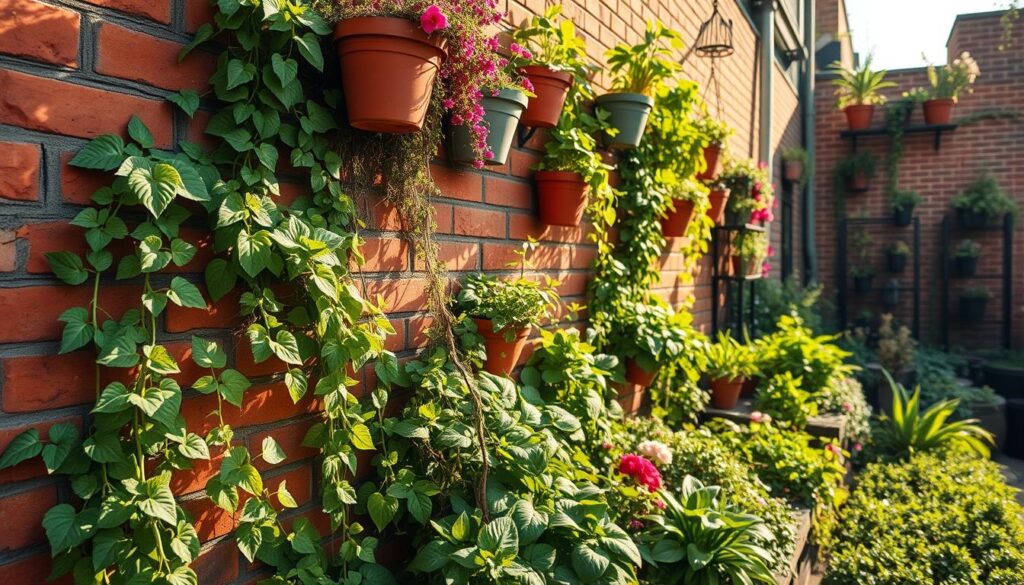
Best Plants for Vertical Gardens
Not all plants are suited for vertical growth. Heavy fruiting varieties like cucumbers, tomatoes, and beans thrive on trellises. Their vines naturally climb, making them ideal for vertical systems.
Shade-tolerant greens, such as spinach and lettuce, can be paired with taller plants. This creates a layered effect, maximizing productivity. Flowering vines like morning glories or nasturtiums add beauty and attract pollinators.
DIY Vertical Garden Ideas
Creating your own vertical system is easier than you think. Recycled materials like pallets can be turned into functional planters. Simply secure them to a wall or fence, add soil, and start planting.
For a more permanent solution, consider building an A-frame structure. These are perfect for cucumbers and other climbing plants. Commercial systems are also available, offering durability and ease of use.
Maintenance is key to keeping your vertical garden thriving. Regularly check for pests, ensure proper watering, and prune as needed. With a little care, your vertical setup will flourish and provide a bountiful harvest.
Companion Planting: A Natural Way to Boost Growth
Companion planting is a time-tested method to enhance your outdoor space naturally. By pairing certain plants together, you can improve growth, deter pests, and create a balanced ecosystem. This technique is rooted in science and has been used for centuries to maximize productivity.
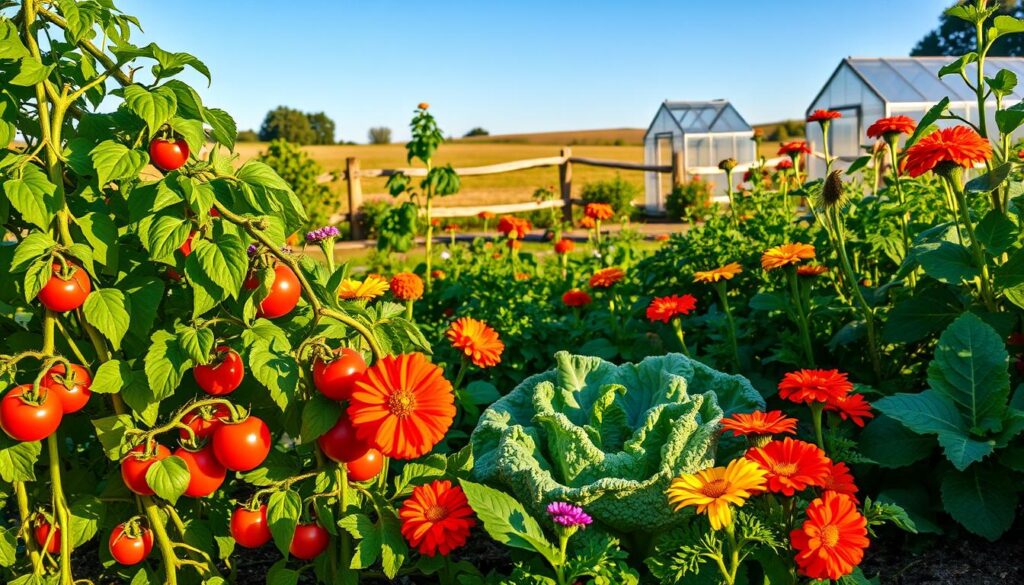
Popular Companion Plant Pairings
Some plants naturally complement each other. For example, the Three Sisters method pairs corn, beans, and squash. Corn provides support for beans, beans fix nitrogen in the soil, and squash shades the ground to retain moisture.
Marigolds are another great companion. Their strong scent repels pests, making them ideal to plant near tomatoes or peppers. Similarly, basil and tomatoes thrive together, enhancing each other’s flavor and growth.
Benefits of Companion Planting
Companion planting offers numerous advantages. It reduces the need for chemical pesticides by naturally deterring pests. Pairing nitrogen-fixing vegetables like beans with heavy feeders like corn improves soil fertility.
Height-based partnerships, such as planting tall sunflowers with low-growing lettuce, maximize space and sunlight. Verified customer gardens have reported increased yields and healthier vegetables using these methods.
| Plant Pairing | Benefits |
|---|---|
| Corn, Beans, Squash | Mutual support, nitrogen fixation, moisture retention |
| Marigolds, Tomatoes | Pest deterrence |
| Basil, Tomatoes | Flavor enhancement, improved growth |
By incorporating companion planting into your garden, you can create a thriving and sustainable environment. Whether you’re growing herbs, flowers, or vegetables, these strategies ensure success and beauty.
Succession Planting: Keeping Your Garden Productive
Keeping your outdoor space productive year-round requires smart planning. Succession planting is a technique that ensures you’re always harvesting fresh crops, no matter the season. By rotating plants strategically, you can make the most of your available time and resources.
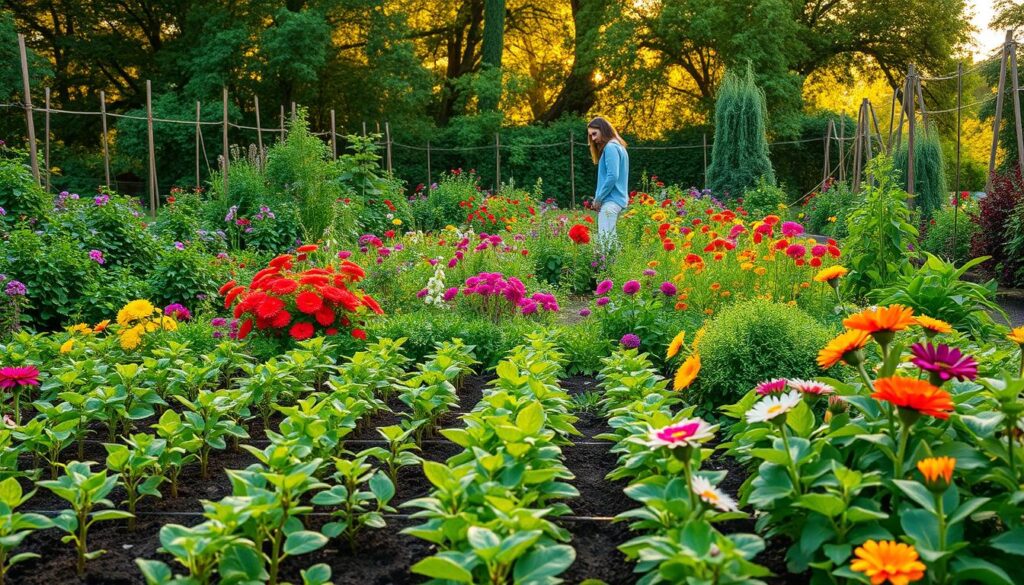
Steven Biggs’ rapini and garlic rotation system is a great example. He plants rapini in early spring, harvests it by early summer, and then replaces it with garlic for the fall. This method keeps the soil active and maximizes yields.
Planning Your Succession Planting Schedule
Start by mapping out your growing season. Divide it into 60-day intervals to plan crop transitions. For example, cool-weather crops like lettuce can be replaced with heat-tolerant varieties like peppers as temperatures rise.
Cold frames are a great tool for extending the growing season. They allow you to start plants earlier in spring and protect them in late fall. Overwintering strategies, such as planting garlic in late fall, ensure a head start for the next year.
Best Crops for Succession Planting
Choose plants with short growing cycles for quick turnover. Here are some top picks:
- Lettuce: Harvest in 30-60 days, perfect for early spring.
- Radishes: Ready in 25-30 days, ideal for quick rotations.
- Beans: Heat-tolerant and productive in summer.
- Spinach: Great for fall planting and overwintering.
By following these tips, you can create a continuous harvest and keep your outdoor space thriving all year long.
Designing Pathways for Easy Access
Designing pathways in your outdoor area can enhance both functionality and aesthetics. Whether you’re navigating between beds or creating a seamless flow, well-planned pathways ensure easy access and add charm to your space.
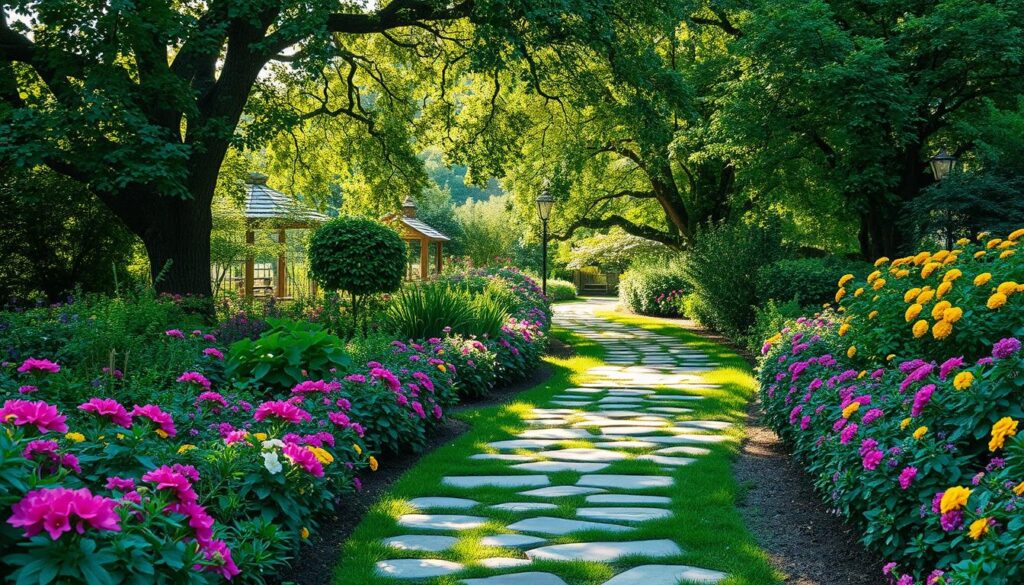
Materials for Outdoor Pathways
Choosing the right materials is crucial for durability and style. Permeable surfaces like gravel or stepping stones allow water to drain, reducing puddles. Solid surfaces, such as concrete or pavers, offer a clean, polished look.
Decorative mulch is another popular option. It’s affordable, easy to install, and blends naturally with the surroundings. For a child or pet-friendly surface, consider rubber mulch or smooth stones that are safe and comfortable to walk on.
Layout Tips for Pathways
When planning your pathway layout, consider accessibility. ADA-compliant designs require a minimum width of 36 inches to accommodate wheelchairs or strollers. Curved pathways can add visual interest, while straight paths provide a direct route.
Lighting integration is another key factor. Solar-powered lights or low-voltage fixtures can illuminate pathways, enhancing safety and ambiance. Keyhole designs, which minimize pathway space, are perfect for compact areas.
By combining the right materials and thoughtful layout, you can create pathways that are both practical and beautiful. Whether you’re working with a large yard or a small plot, these tips ensure your outdoor area is easy to navigate and enjoy.
Incorporating Edible Flowers into Your Garden
Adding edible flowers to your outdoor space can bring both beauty and flavor. These blooms are not just visually stunning—they also offer culinary and health benefits. From salads to teas, edible flowers can transform your meals and elevate your garden design.

Steven Biggs, a gardening expert, often uses nasturtiums and calendula as focal points in his designs. These flowers are not only vibrant but also functional, deterring pests and attracting pollinators. Whether you’re a seasoned gardener or a beginner, edible flowers are a simple way to enhance your space.
Popular Edible Flowers
Not all flowers are safe to eat, but many common varieties are both delicious and nutritious. Here are some favorites:
- Nasturtiums: Peppery flavor, perfect for salads.
- Calendula: Mild taste, often used as a saffron substitute.
- Lavender: Sweet and floral, ideal for desserts and teas.
- Pansies: Mild and colorful, great for garnishing.
These flowers are easy to grow and add a pop of color to your plants and herbs. Pair them with vegetables for a balanced and productive setup.
Growing and Harvesting Edible Flowers
Growing edible flowers is simple, even for beginners. Start by choosing varieties that thrive in your climate. Most edible blooms prefer well-draining soil and full sun, though some, like nasturtiums, tolerate partial shade.
Harvesting is best done in the morning when the blooms are freshest. Use clean scissors to cut the flowers, leaving the stems intact. Avoid using pesticides or chemicals, as these can make the flowers unsafe to eat.
Here’s a quick guide to preserving your harvest:
| Method | Best For |
|---|---|
| Drying | Lavender, calendula |
| Freezing | Pansies, nasturtiums |
| Infusing | Lavender, chamomile |
By incorporating edible flowers into your outdoor space, you can create a stunning and functional area that delights all your senses.
Creating a Pollinator-Friendly Garden
Transforming your outdoor area into a haven for pollinators is both rewarding and impactful. Pollinators like bees, butterflies, and hummingbirds play a crucial role in maintaining healthy ecosystems and boosting crop yields. By designing a space that attracts these beneficial creatures, you can enjoy a thriving and vibrant garden.
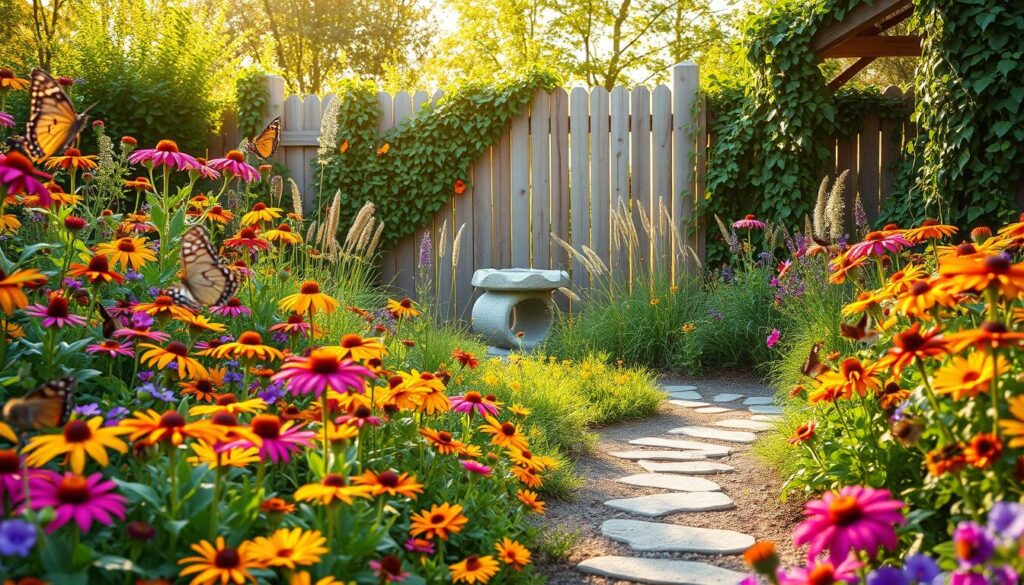
Verified customer gardens have reported yield increases of over 30% by incorporating pollinator-friendly practices. From selecting the right plants to adding water features, every detail matters. Let’s explore how you can create a space that supports pollinators and enhances your outdoor environment.
Plants That Attract Pollinators
Choosing the right plants is the first step in creating a pollinator-friendly space. Native species are particularly effective, as they are well-adapted to your local climate and provide familiar food sources for pollinators. Some top choices include:
- Milkweed: Essential for monarch butterflies.
- Lavender: Attracts bees and adds a lovely fragrance.
- Coneflowers: A favorite of butterflies and bees.
- Sunflowers: Provide nectar and seeds for birds.
Planning a bloom sequence ensures that pollinators have access to food throughout the growing season. Early bloomers like crocuses and late bloomers like asters keep your space active and vibrant.
Designing a Pollinator Garden
Designing a pollinator-friendly space goes beyond plant selection. Incorporating water features, such as shallow birdbaths or small ponds, provides essential hydration for pollinators. Bee hotels offer nesting sites for solitary bees, while pesticide alternatives like neem oil protect pollinators from harmful chemicals.
“A well-designed pollinator garden not only supports wildlife but also creates a beautiful and dynamic outdoor space,” says a gardening expert.
Here’s a quick guide to designing your pollinator-friendly area:
Feature Benefit Native Plants Provide familiar food sources Water Features Offer hydration for pollinators Bee Hotels Create nesting sites Pesticide Alternatives Protect pollinators naturally By focusing on these elements, you can create a space that supports pollinators and enhances the beauty of your outdoor area. Whether you’re growing flowers, herbs, or vegetables, these strategies ensure a thriving and sustainable environment.
Using Containers to Expand Your Garden
Containers offer a versatile way to grow plants in any space. Whether you’re working with a small balcony or a driveway, they provide flexibility and creativity. Steven Biggs’ driveway tomato container system is a perfect example of how you can maximize limited areas.
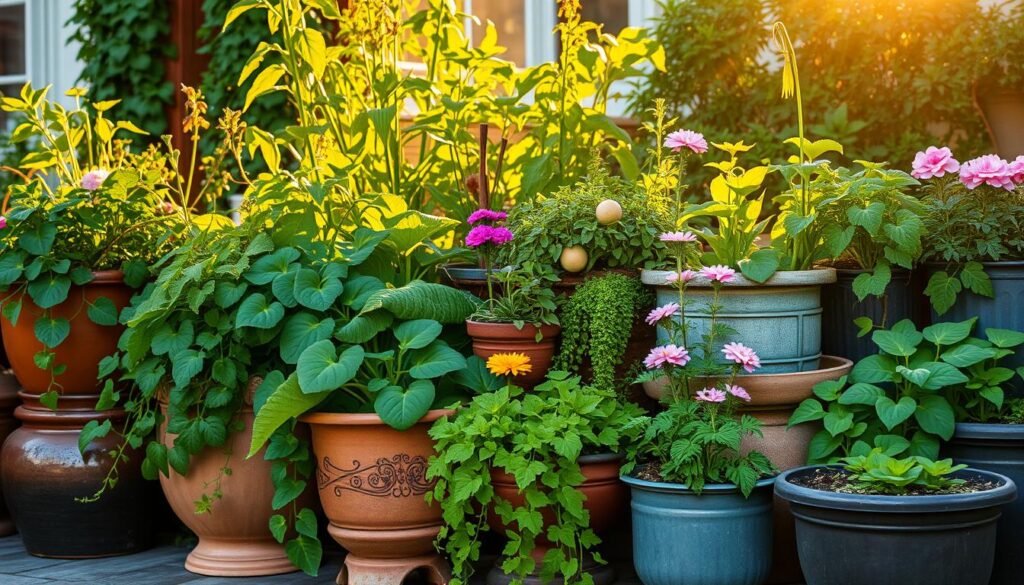
Container gardening is ideal for urban settings or those with limited ground space. You can grow vegetables, herbs, and flowers in pots, making it easy to move them as needed. This method also allows for better control over soil quality and drainage.
Best Plants for Container Gardening
Choosing the right plants is key to success. Dwarf varieties are particularly well-suited for containers. For example, cherry tomatoes, peppers, and compact herbs like basil thrive in pots. These smaller plants don’t require as much root space and are easier to manage.
Self-watering containers are a great option for busy gardeners. They ensure consistent moisture levels, reducing the need for frequent watering. Pairing these with vertical stacking systems can further maximize your growing area.
Container Garden Design Ideas
Designing a container setup involves both functionality and aesthetics. Mobility is a major advantage—containers can be moved to optimize sunlight or protect plants from harsh weather. For winter protection, consider using insulated covers or bringing containers indoors.
Here’s a quick guide to popular container materials:
| Material | Pros | Cons |
|---|---|---|
| Plastic | Lightweight, affordable | Less durable |
| Clay | Breathable, aesthetic | Heavy, fragile |
| Wood | Natural look, sturdy | Prone to rot |
By incorporating these ideas, you can create a thriving and beautiful container garden that fits your lifestyle and space.
Seasonal Garden Layouts: Adapting to the Seasons
Adapting your outdoor space to the changing seasons ensures year-round productivity and beauty. Each season brings unique challenges and opportunities, and planning ahead can help you make the most of your time and resources. Whether it’s preparing for frost or maximizing summer growth, seasonal strategies keep your area thriving.
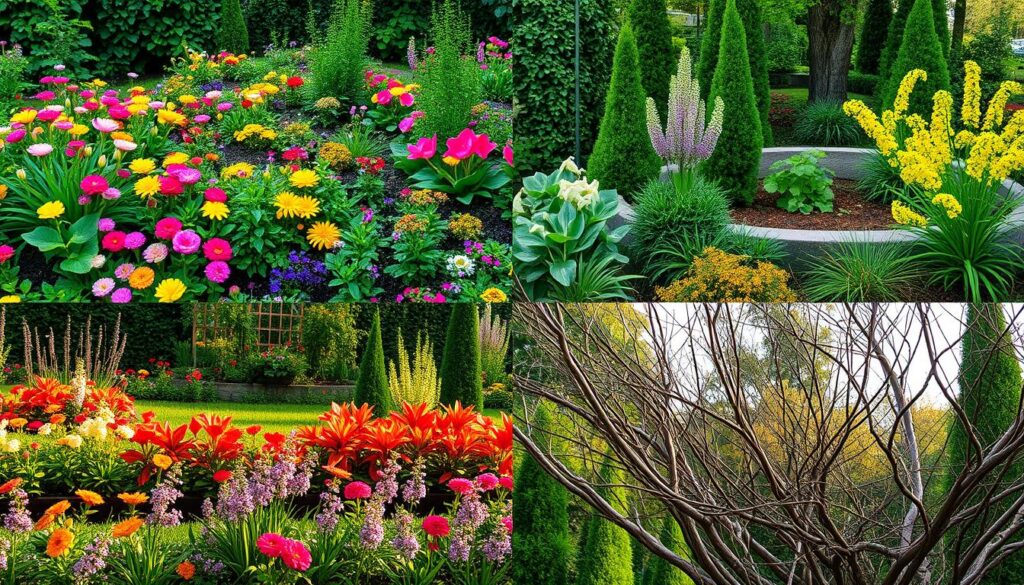
Using tools like frost date calculators and mulching depth guides, you can tailor your setup to suit the season. Almanac’s 10-year curated plans offer valuable insights for optimizing your space. Let’s explore how to adapt your outdoor area for spring, summer, fall, and winter.
Spring and Summer Garden Layouts
Spring is the perfect time to start planting cold-hardy crops like lettuce and spinach. These plants thrive in cooler temperatures and can be rotated with summer varieties as the weather warms. Hoop houses are a great way to extend the growing season and protect young plants from late frosts.
Summer requires strategies to manage heat and sunlight. Shade solutions, such as using taller plants to protect delicate ones, can prevent sunburn. Mulching helps retain moisture and keeps the soil cool. Pairing these techniques ensures a productive and vibrant outdoor space during the warmer months.
Fall and Winter Garden Layouts
Fall is ideal for planting cold-hardy crops like kale and carrots. These plants can withstand cooler temperatures and even light frosts. Rotating crops ensures the soil remains fertile and productive. Hoop houses and cold frames are excellent for extending the growing season into winter.
Winter gardening focuses on protecting plants from harsh conditions. Mulching deeply around the base of plants insulates roots and prevents frost damage. Planning ahead with these strategies allows you to enjoy fresh produce even in the coldest months.
| Season | Key Strategies |
|---|---|
| Spring | Plant cold-hardy crops, use hoop houses |
| Summer | Provide shade, mulch for moisture retention |
| Fall | Rotate crops, use cold frames |
| Winter | Deep mulching, protect from frost |
By adapting your outdoor space to the season, you can enjoy a thriving and productive area all year long. Whether it’s spring planting or winter protection, these strategies ensure success.
Conclusion: Your Path to a Stunning Garden
Transforming your outdoor area into a thriving space is easier than you think. With a well-thought-out layout, you can create a beautiful and functional environment that suits your needs. Rooted Garden’s client transformations show how strategic planning can make a significant difference.
Start with a 12-month planning checklist to stay organized throughout the year. Local resource directories can help you find the best tools and materials. A maintenance calendar ensures your plants stay healthy and vibrant.
Community sharing opportunities allow you to connect with other enthusiasts and exchange tips. Finally, success measurement benchmarks help you track progress and celebrate milestones. By following these steps, your outdoor garden will flourish and bring joy for years to come.

